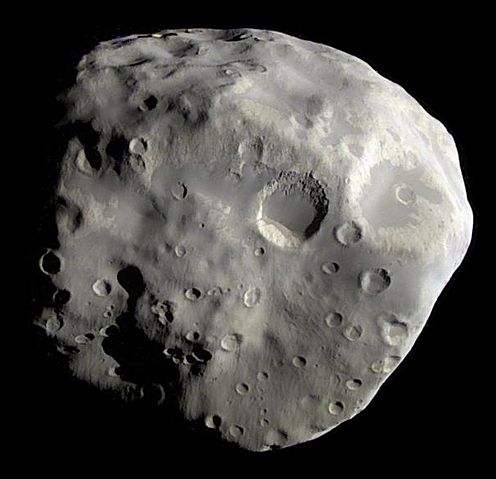 |
This is a file from the Wikimedia Commons. Information from its description page there is shown below.
Commons is a freely licensed media file repository. You can help.
|
| Description |
The Cassini spacecraft's close flyby of Epimetheus in December 2007 returned detailed images of the moon's south polar region. The view shows what might be the remains of a large impact crater covering most of this face, and which could be responsible for the somewhat flattened shape of the southern part of Epimetheus (116 kilometers, or 72 miles across) seen previously at much lower resolution.
The image also shows two terrain types: darker, smoother areas, and brighter, slightly more yellowish, fractured terrain. One interpretation of this image is that the darker material evidently moves down slopes, and probably has a lower ice content than the brighter material, which appears more like "bedrock." Nonetheless, materials in both terrains are likely to be rich in water ice.
The images that were used to create this enhanced colour view were taken with the Cassini spacecraft narrow-angle camera on Dec. 3, 2007. The views were obtained at a distance of approximately 37,400 kilometers (23,000 miles) from Epimetheus and at a Sun-Epimetheus-spacecraft, or phase, angle of 65 degrees. Image scale is 224 meters (735 feet) per pixel.
The Cassini–Huygens mission is a cooperative project of NASA, the European Space Agency and the Italian Space Agency. The Jet Propulsion Laboratory, a division of the California Institute of Technology in Pasadena, manages the mission for NASA's Science Mission Directorate, Washington, D.C. The Cassini orbiter and its two onboard cameras were designed, developed and assembled at JPL. The imaging operations centre is based at the Space Science Institute in Boulder, Colo.
For more information about the Cassini–Huygens mission visit http://saturn.jpl.nasa.gov/home/index.cfm. The Cassini imaging team homepage is at http://ciclops.org. The NASA image has been cropped. |
| Date |
3 December 2007 |
| Source |
http://photojournal.jpl.nasa.gov/catalog/PIA09813 |
| Author |
NASA/JPL/Space Science Institute |
 |
This image or video was catalogued by Jet Propulsion Lab of the United States National Aeronautics and Space Administration (NASA) under Photo ID: PIA09813.
This tag does not indicate the copyright status of the attached work. A normal copyright tag is still required. See Commons:Licensing for more information.
|
Licensing
| Public domainPublic domainfalsefalse |
 |
This file is in the public domain because it was solely created by NASA. NASA copyright policy states that "NASA material is not protected by copyright unless noted". (See Template:PD-USGov, NASA copyright policy page or JPL Image Use Policy.) |
|
|
|
Warnings:
- Use of NASA logos, insignia and emblems are restricted per US law 14 CFR 1221.
- The NASA website hosts a large number of images from the Soviet/ Russian space agency, and other non-American space agencies. These are not necessarily in the public domain.
- Materials based on Hubble Space Telescope data may be copyrighted if they are not explicitly produced by the STScI. See also {{ PD-Hubble}} and {{ Cc-Hubble}}.
- The SOHO (ESA & NASA) joint project implies that all materials created by its probe are copyrighted and require permission for commercial non-educational use.
- Images featured on the Astronomy Picture of the Day (APOD) web site may be copyrighted.
|
File usage
The following pages on Schools Wikipedia link to this image (list may be incomplete):
Through Schools Wikipedia, SOS Children's Villages has brought learning to children around the world. By supporting vulnerable children right through to adulthood, SOS Children's Villages makes a lasting difference to the lives of thousands of people. Education is a key part of our work, and our schools provide high-quality teaching to the children in our care. Want to learn more? Go to http://www.soschildrensvillages.org.uk/sponsor-a-child





